From www.realguns.com it states: “The 500 Jeffery made its original appearance in the mid 1920’s as the August Schüler Company’s 12,7 x 70mm Schuler. As with a number of cartridges of German origin being offered between WWI and WWII, the round was renamed by the British firearm firm Jeffery as the .500 Jeffery to make the chamber more palatable to British sportsmen”
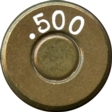
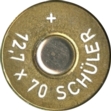
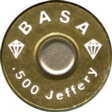 Headstamp made by OPM in South Africa for the Big Bore Association of South Africa
Headstamp made by OPM in South Africa for the Big Bore Association of South Africa
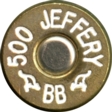
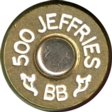
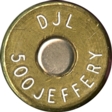 For DJ (Casey) Lewis, on PMP brass. Only about 200 of these were made.
For DJ (Casey) Lewis, on PMP brass. Only about 200 of these were made.
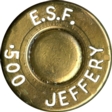
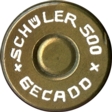
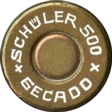
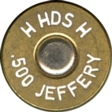
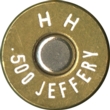
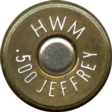
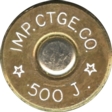
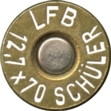
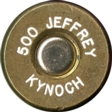
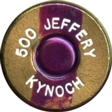
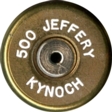
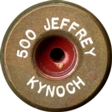
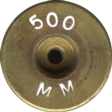 Hand stamped case by Murray McNichol
Hand stamped case by Murray McNichol
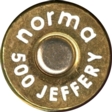
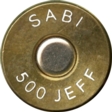
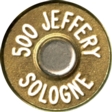
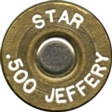
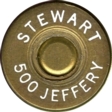
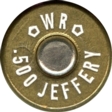
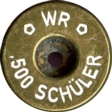
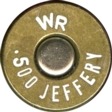





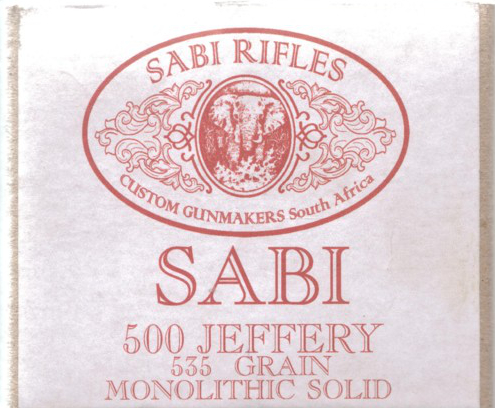

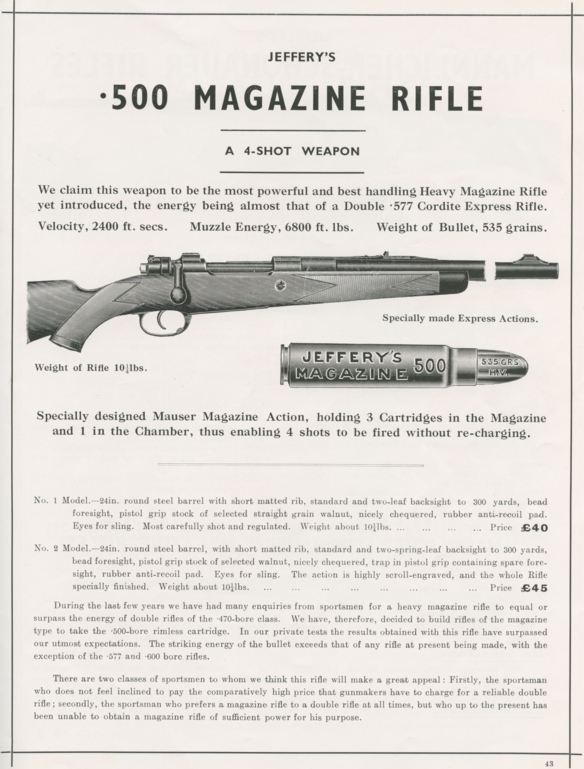
The following is from a booklet by KYNAMCO in 1998 regarding the 500 Jeffery cartridge.
CASE FOR CIP ADOPTION OF KYNOCH DRAWING BK82/132,
August 21, 1928, AS DEFINITIVE DIMENSIONAL SPECIFICATION
OF .500 JEFFERY CARTRIDGE FOR INSERTION IN TDCC’S
HISTORICAL BACKGROUND
There has long been argument over the origins of the .500 Jeffery cartridge and in particular whether it was designed by Jeffery, or adopted by him from the 12.7 x 70 Schüler, or whether Schüler adopted Jeffery’s design. Whether or not he was the designer of the basic case, documentary evidence seems to point towards Jeffery being the first to market his rifle in this calibre, since the surviving records of the company (now held by Messrs Holland & Holland in London) show the first .500 Jeffery rifle to have been sold in 1927. The first documented reference to the Schuler cartridge is recorded(1) as a letter of 18.11.28 offering it to a customer on New York.
It is a common place error in the literature to describe the two cartridges as identical, but this is clearly not so when the original Kynoch Drawing BK82/ 132, dated August 21, 1928, of the .500 Jeffery is compared with the RWS Drawing M466, dated 18/7/40, of the Schuler .500/ 12.7 x 70. The differences in the shoulder position and shoulder angle are significant, and are highlighted in Kynamco Drawing K98/06.
The difference in the cartridges was brought about by the different rifle and loading systems adopted by Jeffery and Schüler. Schüler always built his rifles on a 98 Standard Action with a vertical magazine and a spring clip which held the cartridge as it left the magazine before the bolt picked up the cartridge and pushed it into the chambers. It relied on the extractor springing over the bullet head and a recess was cut into the chamber face to accept this. This method does not require any assistance from a tapered case or neck to assist it’s extraction from the magazine as it just pops up as the bolt moves back and ejects the fired cartridge and is held by the spring clip ready for loading again.
Jeffery on the other hand had all his .500 calibre rifles made on Magnum Mauser Actions and had a stack magazine which meant the cartridge was held under the lip of the magazine box and had to be pushed forward out of the magazine box into the chamber by the bullet face, hence the tapered case and shoulder. angle was reduced to assist its entry into the chamber.
The fundamental difference between the two weapon systems has been forgotten by modern gunmakers and the subtle difference between the cartridges were brought about by the different systems.
The question of the manufacturing provenance of surviving original cartridges is also confusing. No examples are known with a K or KYNOCH headstamp, the only headstamps known (from the pre-WWII era) being an enigmatic “.500” and “x Schuler 500 x GECADO”. There is no doubt that the latter is a .500 Schüler, manufactured by G C Dornheirn of Suhl (Gecado), and loaded with 118gr Smokeless NC Flake powder. However, the “.500” examples are known Cordite loaded(2), undoubtedly in Britain by Kynoch; it has long been supposed that all these “.500” h/s examples were also made and loaded by Gecado, but the Cordite loading makes this virtually impossible, since this propellant was not used by German SAA manufacturers.
The most likely explanation is that Jeffery (or Kynoch on his behalf) imported straight (un-necked) formed Schuler cases, quite probably from Gecado. Cordite, due to its stranded form, was invariably loaded into un—necked cases, over-wadded with a glaze board disc of case body inside diameter to retain the strands at the base of the case and the case was then finally necked over the wad for bulleting. This dual use of the basic case probably explains the lack of any complete calibre designation (such as “.500 Schüler” or “.500 Jeffery”) in the headstamp; both firms promoted their respective versions as a “.500” – Schüler did not use the metric designation in his promotion of the calibre, this appear to have been adopted by RWS in the early 1940s.
This explains the existence of the Kynoch drawing as a loading drawing for the case giving final external dimensions, and a detailed manufacturing drawing of the bullet, which would have been of Kynoch manufacture; German solid bullets of the era were very thin jacketed and would not have been acceptable to Jeffery or their customers. This also indicates independent design by Jeffery and Schuler and intentional differences in the Jeffery cartridge. Although it may have been expedient (and cheaper) for him to import part finished brass using Schüler’s base dimensions from Gecado, the use of a Kynoch bullet and his own sloping shoulder profile was very probably done to intentionally prevent Schuler cartridges being used in Jeffery rifles.
The accompanying photograph shows a comparison of two original Gecado Schüler loads, with the two known headstamps, both NC flake powder loaded, and both with the 47° shoulder angle (as measured on specimens) of the RWS drawing. These are compared with a modern Kynoch (Kynamco) .500 Jeffery (with a nominal 25°, as measured 30° on specimens) and a Romey .500 which has a 68° cone angle as measured on specimens. This and the dimensional correspondence of measured original Schüler specimens to the RWS drawing shows this to have been a copy of the original G C Dornheim drawing, which has disappeared. RWS and Dornheim had a working collaboration from the late 1920s until Dornheim was wholly absorbed by RWS prior to WWII, which would explain the existence of the RWS drawing, showing the intent to continue the manufacture of the Schltiler cartridge by RWS, which was undoubtedly thwarted by the war, since no specimens with the RWS headstamp are known.
COMMERCIAL CONSIDERATIONS
When sportsmen ask their riflemakers for a large bolt action rifle, the 500 Jeffery is always the top of the list. The lore of the calibre has spanned 60 years and is again enjoying a resurgence of popularity. Due to this popularity Kynoch are reproducing the ammunition to the specification and original dimensions of their predecessors, and are now making a further 10,000 rounds of ammunition to satisfy the market. In doing so we have to submit the cartridge to be entered into the CIP tables. This was first done in the early part of this year, but referred back because there was confusion over the dimensions. The historical background and technical considerations with these notes answer these questions. The shooting public do not want a 12.7 x 70 Schüler or a hybrid wildcat – they want a .500 Jeffery, to the original dimensional and ballistic specifications.
From a commercial point of view the 500 Jeffery cartridge to the correct original Kynoch English dimensions will fit the few original Schüler rifles, the original Jeffery rifles and the varying non-standard size chambers found in a few modern rifles made in the last 7 to 8 years. It will also fit and chamber safely in the Wolf “Improved” rifles. So there will not be a problem with the ammunition not fitting rifles in the current marketplace, and there will be no need to recall or alter any rifles, although some owners may like their gunsmith to check this for them.
Chamber reamers and head space gauges to the original Kynoch/Jeffery specifications are available from Arthur Smith, Arms Restoration Services Tel/Fax 01206 272354. Drawings of cartridge and chamber will be sent to all the major reamer manufacturers. Cartridge gauges will be available from Kynamco Limited.
Non—CIP signator countries, e g USA and South Africa are making rifles to the original Jeffery dimensions and have to date taken over 5,000 rounds of ammunition and have ordered a further 10,000 rounds for delivery end 1998.
There has been an enormous amount of mis-information regarding this cartridge. The opportunity has now arisen to the benefit of both manufacturer and private users of the calibre to correct all this and have one definitive specification for this cartridge. With its submission to CIP it will allow owners of both original and new rifles to be confident the ammunition made for this calibre will fit and serve the user as well as the original Jeffery cartridge.
TECHNICAL CONSIDERATIONS
Kynamco Drawing K98/06 gives a detailed overlaid comparison of the shoulder profiles of the .500 Jeffery, from the Kynoch drawing, and the 12.7 x 70 Schuler shoulder is 0.8 mm larger in diameter than the Jeffery case at the mid-point of the Jeffery neck cone. This is known to cause chambering problems in original Jeffery rifles when attempting to feed Schuler dimensioned cases; although the Schüler cartridge may be fired, the bolt in many cases has to be forced to shut, and extraction may be hard.
The same drawing also illustrates the hybrid profile proposed by Romey in 1997. It can be seen that this is much closer to the Schüler than the Jeffery profile, and it is also known that cartridges using this profile give the same hard chambering problems as the Schüler case profile. The Romey proposal is in essence a compromise wildcat cartridge that does not fulfil the requirements for Jeffery chambered rifles, though it may be usable in Schüler rifles. It is however an unnecessary further complication to an already complex problem.
However, K98/06 also demonstrates that the Jeffery profile falls within the Schüler profile except very marginally for a short portion of the neck transition, but, given normal manufacturing tolerances, the Jeffery cartridge will not cause hard chambering problems in a Schuler chambered rifle, and also does not compromise the headspacing of the Schuler rifle, since the front of the Jeffery cone coincides sufficiently well with the front third of the Schuler profile to cause no ignition or safety/pressure problems, as the fireforming expansion that will occur is minimal.
From the technical/dimensional standpoint therefore, it can be seen that the “interchangeability” of these two cartridges is in fact one way; the .500 Jeffery may be readily chambered and safely fired in both Jeffery and Schuler rifle, but the Schuler will not chamber in the Jeffery, particularly in a minimum Jeffery chamber.
It would in many ways be preferable, to demonstrate conclusively the differences and to clarify the many misconceptions about these calibres, if both the Jeffery and the Schuler cartridges were to be adopted into TDCCs under their correct designations and with definitively accurate dimensions from the original respective manufacturer’s drawings. However, if it is the CIP’s preference only to adopt one of these cartridges due to their similarities, it would seem logical that it should be the Jeffery profile as depicted in Kynoch Drawing BK82/ 132, as it alone may be used safely in both chamberings.
REFERENCES
(1) Techel, H. “Die Btichsenmacherfamilie Schuler in Suhl” Patronensammler-Vereinigung e.V., Sonderdruck Mitteilungblatt 1990
(2) Fleming, W. “British Sporting Rifle Cartridges”, Armory Publications, Oceanside CA, ISBN 0—939683-11-3, 1993



Above are scans from the KYNAMCO booklet. I have scanned the cartridges in question in detail for comparison. All shown at 200% scale below. It can be seen that there is a significant difference in the KYNAMCO version, especially the groove thickness:











